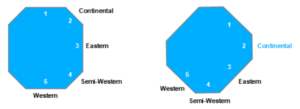Learn tennis tweener
Learning the Tweener on the Tennis Court
Learning the tweener on the tennis court
In every tennis annual highlight, you see the tweener in perfection. A player is outplayed by a lob and runs back and plays the tennis ball through his own legs past the opponent with his back to the net. This shot is called a tweener.
Once seen by the tennis pros, every tennis beginner would like to at least try to play a tweener and avoid unnecessary injury.
Below we explain to tennis beginners how to play the tweener in tennis: from the grip, to the backswing, the movement and the outswing to tweener tips.
1. Tennis tweener grip
The tweener is played one-handed with the strong hand, i.e. as a right-handed player with the right hand and as a left-handed player with the left hand. As a grip we use the backhand topspin grip, the so-called Continental grip. Here the racket is slightly bent forward in the lateral position at the top.

As always, the strong hand grips the handle as far down as possible.
2. Tennis tweener backswing
A tweener in tennis is always suitable when the opponent’s lob has not been played with too much topspin but rather straight, because otherwise the tennis ball will bounce even further after bouncing, making it almost impossible to reach the ball.
The straight lob of the opponent forces you to sprint behind. Your back is facing the net and the tennis ball is already bouncing once. When the ball is descending again it is time to swing the tennis racket forward horizontally in front of your body.
3. Tennis tweener movement
The tennis ball starts to fall and approaches the ground and you stand with the 1st foot as close as possible to the place where the ball will hit. The 2nd foot is placed wide-legged next to it and the racket is dropped from the horizontal in front of the body with the aim of hitting the ball one centimeter in front of the ground and hitting it upwards at an angled angle.
It can happen that the body is already a little further than the tennis ball in the full run. Therefore, try to slow down a little beforehand to avoid tripping over the tennis racket with your own legs.
4. Tennis tweener outswing
Complete the tweener by swinging through the legs. Just before the point of impact, engage your wrist with a snap, similar to the serve, so that the angled angle is increased upward. Caution: Do not swing too far overall or injury may result. At the same time, turn your head towards the net and see where your ball will land. A controlled stroke from this position is rather not granted to a tennis beginner, so be sure to look behind.
Once you have returned the racket to its normal position in front of your body, you can turn completely towards the net to be prepared for another shot.
Note that the backswing, the movement and the outswing are fluid movements.
5. Typical tennis tweener mistakes and tips
a) Don’t jump
The right point of impact just above the ground is particularly difficult for tennis beginners to time. Therefore, they often try to jump up early and then hit the ball. Most of the time they hit the ball directly into the ground. Therefore, be sure to decide not to jump, but to deliberately drop the ball low.
b) Watch the ball closely
The opponent’s lob should be watched closely, because sometimes a tweener, as much as you would like to try it, is not the right shot. This is true, for example, if the lob is played with a lot of forward spin and bounces so far. The chances of you catching up to this ball and playing a tweener are very slim. Look closely at the bounce or ideally already anticipate the bounce and run into position accordingly.
c) Do not give up
The tweener is certainly not the easiest shot in tennis. Therefore, don’t be discouraged if the success rate is close to 0, especially at the beginning. No master has fallen from the sky, but every attempt brings you a little closer to your goal – just don’t give up.

